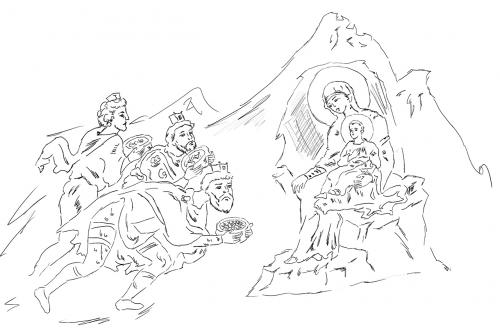



The Adoration of the Magi
In Byzantine and post-Byzantine art the theme of The Adoration of the Magi is frequently included in representations of The Nativity of Jesus (see the canon of The Nativity of Jesus), but it may be treated by itself. As an individual subject, The Adoration of the Magi has a simple structure: the Virgin, holding the Child to her chest, is placed against the background of the cave, or, in depictions influenced by the Western art, by the manger. She is partially looking towards the magi who are kneeling down in front of her presenting their gifts. Secondary characters, such as St. Joseph or angels, may appear in more elaborated variants. The Magi, whose number is not mentioned in the Gospel, are canonically shown as three persons, probably due to the number of gifts offered: gold, frankincense and myrrh (cf. Matthew, 2:9-11). Their social rank, age or place of origin are also not mentioned, but popular and apocryphal literature were free to bestow on them different attributes, even multiplying their number to 12, as the Apostles. This is the explanation why the Byzantine art canon lacks a standard representation, however specifying their number - three, and their influential social position: either kings or magi. They are shown riding towards the cave, guided by the Star, or presenting their gifts.
In Byzantine and post-Byzantine art the theme of The Adoration of the Magi is frequently included in representations of The Nativity of Jesus (see the canon of The Nativity of Jesus), but it may be treated by itself. As an individual subject, The Adoration of the Magi has a simple structure: the Virgin, holding the Child to her chest, is placed against the background of the cave, or, in depictions influenced by the Western art, by the manger. She is partially looking towards the magi who are kneeling down in front of her presenting their gifts. Secondary characters, such as St. Joseph or angels, may appear in more elaborated variants. The Magi, whose number is not mentioned in the Gospel, are canonically shown as three persons, probably due to the number of gifts offered: gold, frankincense and myrrh (cf. Matthew, 2:9-11). Their social rank, age or place of origin are also not mentioned, but popular and apocryphal literature were free to bestow on them different attributes, even multiplying their number to 12, as the Apostles. This is the explanation why the Byzantine art canon lacks a standard representation, however specifying their number - three, and their influential social position: either kings or magi. They are shown riding towards the cave, guided by the Star, or presenting their gifts.




